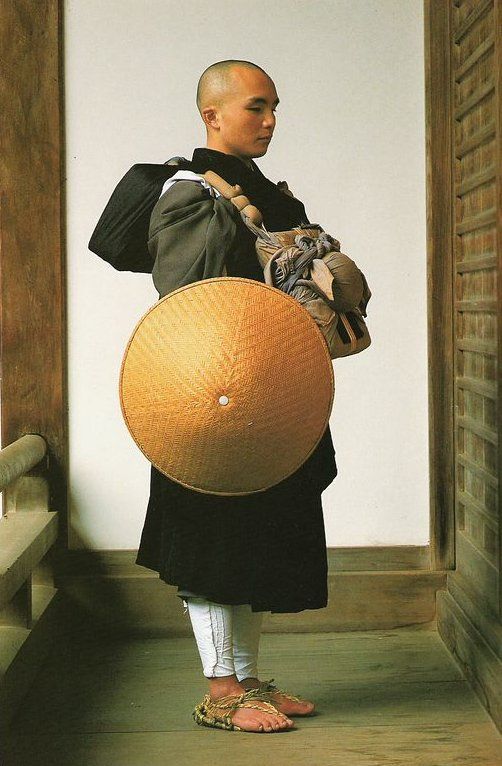 Blue Cliff Record, Case 4
Blue Cliff Record, Case 4
When Te Shan arrived at Kuei Shan, he carried his bundle with him into the teaching hall, where he crossed from east to west and from west to east. He looked around and said, “There’s nothing, no one.” Then he went out.
Hsueh Tou added the comment, “Completely exposed.”
But when Te Shan got to the monastery gate, he said, “Still I shouldn’t be so coarse.” So he reentered [the hall] with full ceremony to meet [Kuei Shan]. As Kuei Shan sat there, Te Shan held up his sitting mat and said, “Teacher!” Kuei Shan reached for his whisk, whereupon Te Shan shouted, shook out his sleeves, and left. Hsueh Tou added the comment,
“Completely exposed.” Te Shan turned his back on the teaching hall, put on his straw sandals, and departed.
That evening Kuei Shan asked the head monk, “Where is that newcomer who just came?”
The head monk answered, “At that time he turned his back on the teaching hall, put on his straw sandals, and departed.”
Kuei Shan said, “Hereafter that lad will go to the summit of a solitary peak, build himself a grass hut, and go on scolding the Buddhas and reviling the Patriarchs.” Hsueh Tou added the comment, “He adds frost to snow.”
Reflections
Reflecting on this koan had brought up lots of questions.
What is Te Shan’s “bundle?”
Is it his bundle of commentaries on the Diamond Sutra? Or his travel bundle of robes, begging bowl, and razor?
Probably can’t be his commentaries because he had already burned them before going to Kuei Shan’s.
Is there a difference between Hsueh Tou’s first and second “completely exposed?”
Who is exposed Te Shan or Kuei Shan?
Or is it a “what” rather than a “who” that is exposed?
If so, “what” is exposed?
What about Yuan Wu’s imagery of the cat and leopard? Who is the cat? Who is the leopard? Or do they possibly change places?
Sekida comes down on the side of the bundle being a “pilgrim’s bundle.” And he has Te Shan saying “Mu, Mu.” Does mu add another dimension to the koan? Picture the scene. Te Shan comes to Kuei Shan’s monastery. Te Shan, backpack over his shoulders, enters the zendo. It is full of monks. Te Shan walks from one side to the zendo to the other, back and forth, back and forth. And he says. Mu, or Empty, or There’s nothing here, or, there’s nobody here. Was he looking for a place to sit and couldn’t find one? So he leaves the zendo. He gets to the monastery gate and thinks better of his haste. He hadn’t after all done his greeting bows to the Master of the temple, Kuei Shan. Great disrespect. So he returns to do so.
He returns goes directly to Kuei Shan, takes his zagu out of his sleeve holds it up prior to placing it down on the floor for bows, says, “Teacher.” And in that instant Kuei Shan waves his hossu at Te Shan, and simultaneously with the wave Te Shan shouts a “Katsu,” folds his zagu, instead of bowing, he turns around and leaves the zendo for good.
Later Kuei Shan asks his attendant, “Who was that masked man?”
So what is Te Shan all about? Is there a cocky confidence to Te Shan? Is he saying This ain’t the place for me. There’s nothing I can learn here. And mind you, on the first go around he completely ignores the Master of the temple, Kuei Shan, exhibiting great disrespect.
And what about Hsueh Tou’s “completely exposed,” or “seen through?” What is seen through? What is exposed?
Here are some possibilities.
Te Shan
Kuei Shan
Both
Neither
Which reminds me of the famous zen syllogism for emptiness:
A
B
Ab
Neither A or B
So is Te Shan talking about Kuei Shan’s place being an expression of emptiness? Is his comment not an insult but an expression of the highest admiration? If so why does he leave? Why does he enter the zendo with his backpack still on his back? Was there no intention to stay to begin with? Why does he ignore Kuei Shan the first time around? All of which points once again to derogation.
Then there’s the matter of the images of frost and snow. What is the meaning of the frost on top of snow? Is Te Shan the frost and Kuei Shan the snow?
Is Hsueh Tau saying that Te Shan surpasses the attainment of Kuei Shan?
Lots of great stuff in this koan. Lots to mull about. Lots to chew upon. Enjoy.
When Te Shan arrived at Kuei Shan, he carried his bundle with him into the teaching hall, where he crossed from east to west and from west to east. He looked around and said, “There’s nothing, no one.” Then he went out.
Hsueh Tou added the comment, “Completely exposed.”
But when Te Shan got to the monastery gate, he said, “Still I shouldn’t be so coarse.” So he reentered [the hall] with full ceremony to meet [Kuei Shan]. As Kuei Shan sat there, Te Shan held up his sitting mat and said, “Teacher!” Kuei Shan reached for his whisk, whereupon Te Shan shouted, shook out his sleeves, and left. Hsueh Tou added the comment,
“Completely exposed.” Te Shan turned his back on the teaching hall, put on his straw sandals, and departed.
That evening Kuei Shan asked the head monk, “Where is that newcomer who just came?”
The head monk answered, “At that time he turned his back on the teaching hall, put on his straw sandals, and departed.”
Kuei Shan said, “Hereafter that lad will go to the summit of a solitary peak, build himself a grass hut, and go on scolding the Buddhas and reviling the Patriarchs.” Hsueh Tou added the comment, “He adds frost to snow.”
